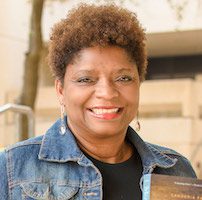Set in the small, fictional town of Maeby, Arkansas in the mid-1960s, Sanderia Faye’s debut novel Mourner’s Bench is a rich and complex portrayal of the changes a segregated town encounters as it becomes a hotbed of civil rights activism.
The story of the town’s integration is told through the voice of Sarah, the novel’s young protagonist. In Sarah, Faye gives readers a sassy and astute narrator—mature and young, wise, precocious, and innocent. A young girl steeped in her town’s morals and values, Sarah is a product of her grandmother and great-grandmother’s strict religious upbringing. Consumed with preparing her soul for salvation and taking her place on the mourner’s bench in hopes of getting baptized come next revival, Sarah’s quiet life of chores, church, and contemplation is disrupted when her makeup- and miniskirt-wearing mother, Esther, returns from Chicago with the goals of taking over Sarah’s upbringing and integrating the town of Maeby.
Troubled by her prodigal mother’s involvement with SNCC (Student Nonviolent Coordinating Committee) and her attempts to integrate local establishments and register black voters, Sarah is initially caught between her mother’s activism and her congregation’s conservatism. Sarah’s neighbors and fellow church members are “more worried about… toilets and farm animals than integrating schools and demanding equal rights” and they want no part of the violent and financial reprisals that they associate the civil rights movement.
As one whose loyalties and sympathies lie with two warring groups, Sarah’s narration reflects her struggle to fuse her appreciation for her small-town life and her love of both family and church with her growing understanding of justice and equality and her burgeoning respect for her mother’s efforts. The writing is at its strongest when Sarah adopts a communal voice:
We grew most of our food in the garden, like whippoorwill, purple hull, crowder and black-eyed peas, and cabbage, turnip, collard and mustard greens, and every other kind of vegetable that survived the heat, weeds and insects. Whatever we didn’t grow or raise, we bartered for with our neighbors.

Her understanding of her town’s way of life comes through when she describes Maeby’s social and economic disparity: “Our streets weren’t paved and didn’t have signs with names written on them like Markham or Carol Lane as they did on the white side of town. We had gravel roads, and we named them ourselves.” Simultaneously combining the authority of an insider with the easy acceptance of a child, Sarah’s voice is free of condescension and judgment as she details the stark reality of segregation.
Faye’s novel is not colored by post-Civil Rights nostalgia. Instead of showing well-dressed groups of African Americans and their white supporters marching hand in hand while solemnly singing “We Shall Overcome,” Mourner’s Bench instead shows the darker side of the Civil Rights movement. The novel focuses not just on the struggles activists faced when confronted by white supremacists or anti-civil rights groups, but also on the resistance they faced from members of the black community, who denounced them out of fear or self-preservation. Faye’s novel depicts dissension among the ranks, highlights the sexism black women encountered within the movement from their male counterparts, shows the structural problems that plagued some Civil Rights organizations, and complicates the role religion played within the movement. Faye chronicles the constant wear and tear of the struggle on the bodies and psyches of the activists, recounting the emotional, financial, and physical toll of frequent arrests, beatings, threats, and other forms of public humiliation and intimidation that were endured by children and adults alike.
Faye’s writing is detailed and descriptive, depicting moments that richly capture life in a small segregated and impoverished town. There are, however, inconsistencies that dim the novel’s shine. Despite the liveliness of the narration, Faye’s narrator too often speaks with a wisdom and vocabulary far beyond her years. Short on dialogue, action and conflict are frequently described rather than rendered. The novel makes occasional unexplained leaps in time, contains sections that are rushed and quickly plotted and tackle too many issues. Chapter titles often undercut the novel’s dramatic tension by prematurely announcing the conflict and telling the reader exactly what to expect. Nevertheless, Mourner’s Bench is a well-researched and commendable debut effort that expands and complicates the body of literature written about the Civil Rights movement by asking readers to lend equal consideration and weight to the roles age, gender, and religion played.




